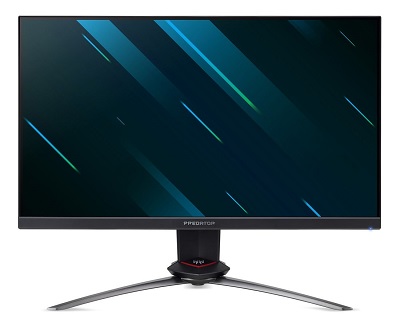Acer XB253Q GP, XB253Q Gx and XB253Q GW 144Hz+ Full HD IPS
As an Amazon Associate and Newegg Affiliate I earn from qualifying purchases made using the “Buy” button at the bottom of this post. Where possible, you'll be redirected to your nearest store. Further information on supporting our work.Update: Updated to include 280Hz ‘GW’ variant. Our review of the 144Hz ‘GP’ variant has been published. News piece below initially published 31st May 2020.
Monitors with high refresh rate IPS panels have been around for a while and are now fairly ubiquitous. It’s only recently that these were available in ~24″ Full HD flavour. The Acer XB253Q GP (XB253Q GPbmiiprzx), XB253Q Gx (XB253Q Gxbmiiprzx) and XB253Q GW offer this combination, with a 144Hz, 240Hz and 280Hz refresh rate, respectively. The monitors are members of the Predator series of gaming monitors and identify themselves as such very clearly with a fairly aggressive look. The stand design is distinctive, with a metallic tripod-like base and a red region above the stand base and neck attachment point. The bottom bezel is black matte plastic, whilst the top and side bezels adopt a slender dual-stage design. This includes a sleek panel border that’s flush with the rest of the screen and a slim hard plastic outer component. The OSD (On Screen Display) is controlled by a joystick and pressable buttons at the rear of the monitor, towards the right side as viewed from in front. The ‘GW’ model includes an ‘RGB LightSense’ bar on the bottom bezel which can be synchronised to the audio and customised in other ways via the OSD.
The monitors use a 24.5″ IPS-type (In-Plane Switching or similar) panels with a 1920 x 1080 (Full HD) resolution, 1000:1 static contrast ratio and 178°/178° horizontal/vertical viewing angles. More specifically, AUO AHVA (Advanced Hyper-Viewing Angle) panels are used. The ‘GP’ model offers a 144Hz refresh rate whilst the ‘Gx’ goes up to 240Hz and ‘GW’ up to 280Hz (internal overclocking). All three models support Adaptive-Sync. This includes AMD FreeSync and Nvidia’s ‘G-SYNC Compatible Mode’, with a 48Hz floor of operation and LFC (Low Framerate Compensation) supported. True 8-bit colour is supported and a medium matte anti-glare screen surface is employed for good glare handling. A flicker-free backlight is used, offering 99% sRGB colour space coverage and a 400 cd/m² typical maximum luminance. VESA DisplayHDR 400 certification is provided, the lowest level that VESA will certify for and only an extremely basic HDR experience in this case. There is no contrast advantage such as local dimming required for this, the peak luminance is relatively low and the colour gamut is very restrictive for HDR. A 10-bit colour signal is leveraged (with the help of GPU dithering), though, enhancing precision.
Low Blue Light (LBL) settings are included to enhance viewing comfort, whilst a 2ms (‘GP’) and 1ms (‘Gx’) grey to grey response time is specified. As usual pay very little attention to such misleading figures and certainly pay no attention to mention of “0.9ms grey to grey” (‘Gp’) or “up to 0.5ms grey to grey” as included in some marketing material. In keeping with other Predator models, the monitor attaches centrally with a quick-release mechanism. It can be easily removed to make way for an alternative 100 x 100mm VESA compatible solution. There’s a flip-down headphone hook towards the top of the stand base and a hexagonal cable-tidy loop lower down. Most of the ports face downwards and include; AC power input (internal power converter), 2 HDMI 2.0 ports, DP 1.4, 2 USB 3.0 ports and a 3.5mm headphone jack. 2 further USB 3.0 ports are located on the left side of the monitor. 2 x 2W speakers are also included, for basic sound output.

Further information on the GP and Gx can be found on the manufacturer’s website. The ‘GP’ is listed for ~$280 and ‘Gx’ for ~$380. The ‘GW’ is listed for ~$400 USD.



